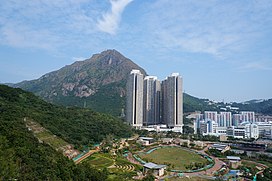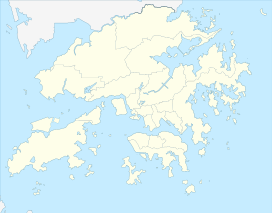Kowloon Peak,[1] also known as Fei Ngo Shan (literally: "Soaring Goose Mountain"), is a 602 m (1,975 ft) tall mountain in the northeast corner of New Kowloon, Hong Kong, situated in Ma On Shan Country Park.[2] It is the tallest mountain in Kowloon, and is crossed by both the Wilson Trail and the MacLehose Trail. On the lower slopes of Tung Yeung Shan about 1.1 miles (1.8 kilometres) to the north is the Gilwell Campsite, belonging to The Scout Association.
| Kowloon Peak | |
|---|---|
| 飛鵝山 | |
 View of Kowloon Peak | |
| Highest point | |
| Elevation | 602 m (1,975 ft) Hong Kong Principal Datum |
| Coordinates | 22°20′27.16″N 114°13′23.64″E / 22.3408778°N 114.2232333°E |
| Geography | |
| Location | |
| Kowloon Peak | |||||||||||||||||
|---|---|---|---|---|---|---|---|---|---|---|---|---|---|---|---|---|---|
| Traditional Chinese | 飛鵝山 | ||||||||||||||||
| Simplified Chinese | 飞鹅山 | ||||||||||||||||
| Cantonese Yale | Fēi ngòh sāan | ||||||||||||||||
| Literal meaning | Soaring Goose Mountain | ||||||||||||||||
| |||||||||||||||||
Geography edit
Kowloon Peak has a steep slope facing South towards northwestern Kowloon, while having a relatively smooth curve towards the east and west. The peak connects with Middle Hill, known as Cheung Shan (象山), and Tung Shan (東山) in the north, forming a ridge of mountains.[3] Despite being in an easy accessible place by car and walks, there are occasional sighting reports of Burmese Python,[4] East Asian Porcupine,[5] Red Muntjac[6] and Wild Boar.[7]
Geology edit
Kowloon Peak consists of mainly volcanic rocks (many of which are tuffs), and blocks of granite at the base of the mountain.[3]
Hiking and access edit
There are several paths from Jat's Incline and Fei Ngo Shan Road that lead to the summit. One of Hong Kong's most treacherous and dangerous climbs is the rock climb from Clear Water Bay Road to Kowloon Peak's summit through Suicide Cliff.
Suicide Cliff is not necessarily a place where people commit suicide, but it is such named most likely because the climb is so treacherous, it is akin to committing suicide. The hike has also seen numerous injuries and fatalities.[8][9][10] In one instance, two mainland Chinese tourists ran into trouble on Kowloon Peak's Suicide Cliff and caused an extensive rescue operation involving 160 firefighters.[11]
For casual hikers, choosing the easiest path to the summit through Fei Ngo Shan Road is recommendable.
See also edit
References edit
- ^ "GeoInfo Map.Map of Hong Kong provided by HKSARG". www.map.gov.hk. Retrieved 2021-04-14.
- ^ "飛鵝山 Fei Ngo Shan/ Kowloon Peak". www.hiking.com.hk. Retrieved 2019-10-26.
- ^ a b Agriculture, Fisheries and Conservation Department (2006-10-17). Central Ridge and West (in English and Chinese). Hong Kong: Cosmos Books Limited. p. 57. ISBN 9882113273.
- ^ "Burmese Python - Python bivitattus". HongKongSnakeID.com. Retrieved 2024-01-28.
- ^ Wildcreatures (2018-03-19). "Mammals: Porcupine". WildcreaturesHK. Retrieved 2024-01-28.
- ^ Dewolf, Christopher (2020-12-15). "Hong Kong's Wild Animals, Part III: Barking Deer". Zolima City Magazine. Retrieved 2024-01-28.
- ^ "Wild Pig Nuisance". www.afcd.gov.hk. Retrieved 2024-01-28.
- ^ "Hiker dies after falling down steep slope in Hong Kong country park". sg.news.yahoo.com. Retrieved 2020-04-29.
- ^ Standard, The. "Another hiker killed". The Standard. Retrieved 2019-10-26.
- ^ "6 girls rescued at Kowloon Peak after getting lost on hike since yesterday". www.msn.com. Retrieved 2019-10-26.
- ^ "Hikers underestimate danger of 'suicide cliff' in Hong Kong". South China Morning Post. 2017-08-28. Retrieved 2019-10-26.
